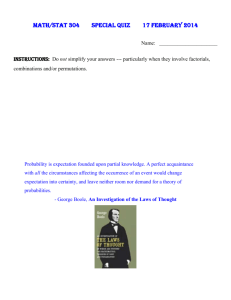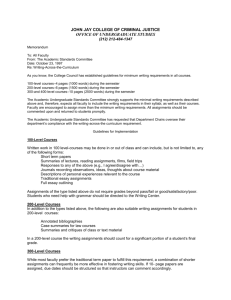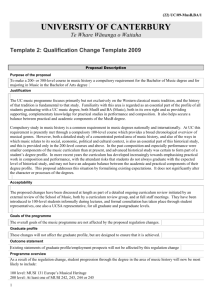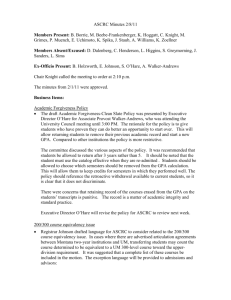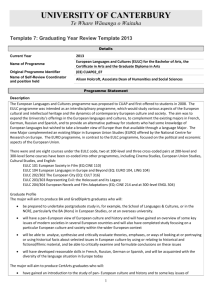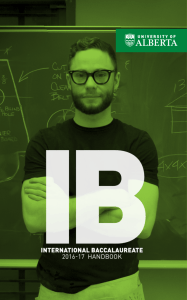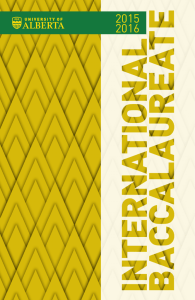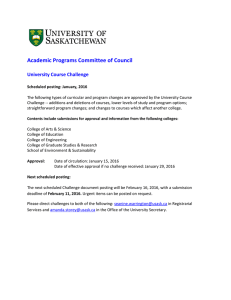Math/Stat 304 Solutions: Special Quiz
advertisement
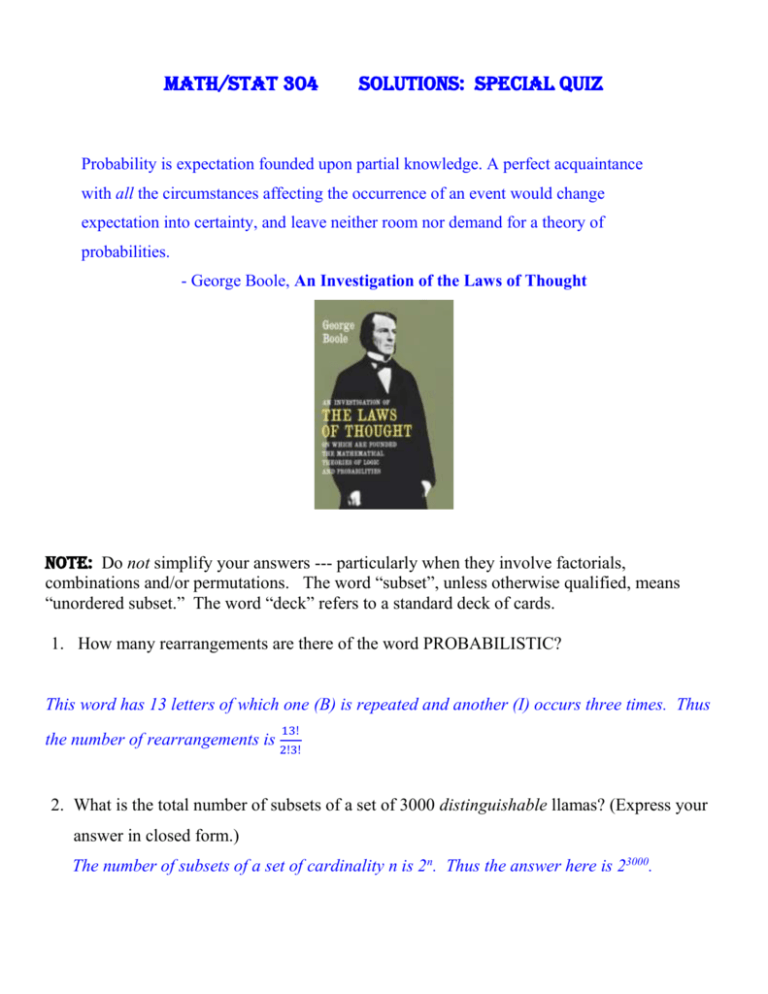
Math/Stat 304
Solutions: Special Quiz
Probability is expectation founded upon partial knowledge. A perfect acquaintance
with all the circumstances affecting the occurrence of an event would change
expectation into certainty, and leave neither room nor demand for a theory of
probabilities.
- George Boole, An Investigation of the Laws of Thought
Note: Do not simplify your answers --- particularly when they involve factorials,
combinations and/or permutations. The word “subset”, unless otherwise qualified, means
“unordered subset.” The word “deck” refers to a standard deck of cards.
1. How many rearrangements are there of the word PROBABILISTIC?
This word has 13 letters of which one (B) is repeated and another (I) occurs three times. Thus
the number of rearrangements is
13!
2!3!
2. What is the total number of subsets of a set of 3000 distinguishable llamas? (Express your
answer in closed form.)
The number of subsets of a set of cardinality n is 2n. Thus the answer here is 23000.
2
3. What is the total number of subsets of a set of 100 indistinguishable tootsie rolls?
Since the set consists of indistinguishable objects, the only choice to make is the number of
objects in the subset: 0 tootsie rolls, 1 tootsie roll, 2 tootsie rolls, etc.
Thus there are 101 subsets.
4. How many subsets of 8 cards from a deck of 52 contain exactly 4 distinct pairs? (Note “4 of
a kind” does not count as two pairs.)
First choose 4 ranks and then 2 from each rank:
13 4 4
( )( )
4 2
5. How many subsets of 5 cards from a deck of 52 contain no pair?
13
First choose 5 ranks and then 1 from each rank: ( ) 45
5
6. How many subsets of 6 cards from a deck of 52 contain exactly 3-of-a-kind but not an
additional pair (nor 4-of-a-kind or a second 3-of-a-kind)?
First choose 1 distinguished rank and then 3 cards from this rank.
Next, choose three other ranks from the remaining 12 and one card from each of these
ranks.
4 12
(13) ( ) ( ) 43
3 3
7. How many subsets of 10 cards from a deck of 52 contain exactly 5 red cards and exactly 5
black cards?
First choose 5 cards from 26 red cards and then 5 cards from the remaining 26 black cards:
26 26
( )( )
5
5
3
8. Inmates at the Oz Penitentiary wear either Blue uniforms or Red uniforms. Thirty-five
prisoners line up to go to sports activities; 15 of them wear Red uniforms and the rest wear
Blue uniforms. How many possible lines can be formed if no two inmates wearing Red
uniforms are allowed to stand side-by-side?
Here we view the Blue uniforms as a sequence of 20 stars; between contiguous stars (as well as
before the first star and after the last star) we insert a dash. So there are 21 dashes, from which
21
we should choose 15 to accommodate the Red uniforms. This gives us ( ) ways. Now for
15
each configuration, we can name the Reds in 15! ways and name the Blues in 20! ways. Thus
21
there are ( ) 20! 15! ways of lining up the inmates.
15
9. A red die, a blue die, and a yellow die (all 6 sided) are rolled. How many outcomes are
there if the number on the red die is (strictly) less than the number on the blue die, which in
turn is (strictly) less than the number on the yellow die?
Here we associate with each desired outcome an ordered subset of three increasing numbers
between 1 and 6. This is equivalent to choosing 3 numbers from {1, 2, 3, 4, 5, 6}. The
6
number of ways of performing this is ( ).
3
10. In how many ways can 5 people {A, B, C, D, E) line up if there must be exactly one person
between A and B?
First, we will choose the person X who stands between A and B. There are 3 such people to
select from. Then we decide if A stands to the left or right of B. Once those choices have
been made, we can “glue” A, B, X together. Now we can permute the remaining two people
with the “glued” triple in 3! ways. So our answer is 3(2)(3!).
4
11. An urn contains 5 distinguishable Red balls, 7 distinguishable Blue balls and 8
distinguishable White balls. In how many ways can one select an (unordered) subset of 8
balls containing 3 Red, 3 Blue and 2 White balls?
5 7 8
Using the multiplication principle, the answer is ( ) ( ) ( ).
3 3 2
12. A four-sided die is flipped 20 times. (Here, order counts.) In how many ways can one
obtain exactly 8 ones, 5 twos, 4 threes and 3 fours?
First choose the locations of the 8 ones from the 20 flips; then choose the locations of the 5
twos from the remaining 12 flips, and then choose the location of the 4 threes from the
20 12 7
remaining 7 locations. Hence the answer is ( ) ( ) ( ).
12 5 4
13. In how many ways can you be dealt 6 cards (where order matters) in such a way that the
second ace appears on the 6th (and last) card?
First, any one of the four Aces can be used for the 6th card. Next, the other ace (one of the
remaining 3) can appear as any of the 1st through 5th cards. Finally, one must choose 4
non-aces and insert them in the remaining 4 positions. Thus the answer is:
(4)(3)(5) (48) 4!
4
5
14. An elevator starts at the first floor with 17 people (not including Albertine, the elevator
operator) and discharges them all by the time it reaches the eleventh floor. In how many
different ways could Albertine have perceived the people leaving the elevator if all people
look alike to her? (Note: nobody exits on the first floor.)
Here we can treat the 17 people as 17 stars. To obtain a distribution over 10 floors (2nd
through 11th ), we need 9 slashes (representing barriers between floors). Then the answer to
our problem equals the number of all 26 letter “code words” consisting of 17 stars and 9
26
slashes. This number is ( ).
9
15. A drawer contains 11 pairs of gloves (each pair of a different style and color). In how
many ways can one choose (an unordered set of) six gloves that includes exactly two pairs
of gloves of the same style and color?
First choose two pairs from the 11; then choose two other pairs, from which one may select a
right or left glove. Thus the answer is (
11 9 2
)( )2 .
2 2
6
16. Vladimir, at point A, must meet Estragon at point B. But first Vladimir must stop at the
hardware store, point C, to purchase some rope. In how many ways can Vladimir achieve
this journey if he takes the shortest route in each of the two sub-trips?
9
Traveling from A to C requires 4 units west and 5 units north. This can be achieved in ( )
4
ways. Traveling from C to B requires 10 units east and 3 units north. This can be achieved in
13
9 13
( ) ways. Using the multiplication principle, the final answer is ( ) ( ).
10
4 10
7
17. The Astrology Department of the University of Oz offers nine (different) 100-level
courses, ten (different) 200-level courses, and thirteen (different) 300-level courses. A fulltime student must select two 100-level courses and three upper-level (meaning 200-level or
300-level) courses with the stipulation that she must have at least one 200-level course and
at least one 300-level course. If Odette wishes to be a full-time student, in how many ways
can she choose her curriculum?
There are two mutually exclusive options:
(A) two 100-level courses AND two 200-level courses AND one 300-level course
(B) two 100-level courses AND one 200-level course AND two 300-level courses
Thus the number of ways of achieving A or B is:
9 10 13
9 10 13
( )( )( ) + ( )( )( )
2 2
1
2 1
2
